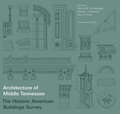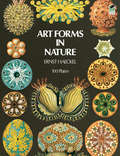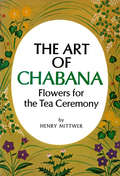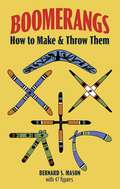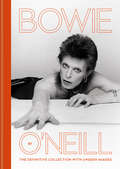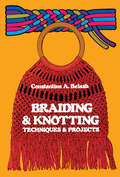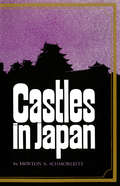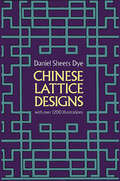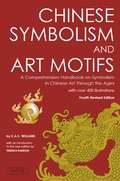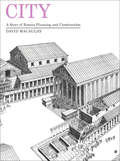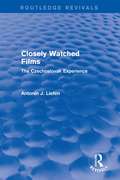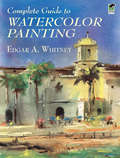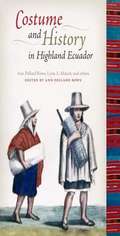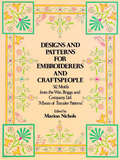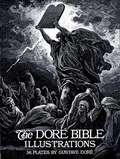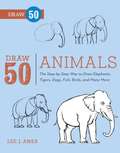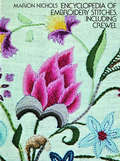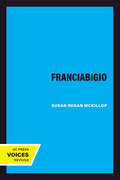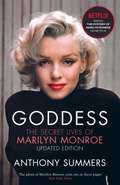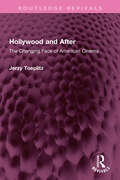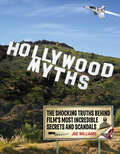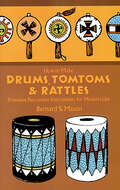- Table View
- List View
Architecture of Middle Tennessee: The Historic American Buildings Survey (Vintage Vanderbilt)
by Aja BainFirst published in 1974, Architecture of Middle Tennessee quickly became a record of some of the region's most important and most endangered buildings. Based primarily upon photographs, measured drawings, and historical and architectural information assembled by the Historic American Buildings Survey of the National Park Service in 1970 and 1971, the book was conceived of as a record of buildings preservationists assumed would soon be lost. Remarkably, though, nearly half a century later, most of the buildings featured in the book are still standing. Vanderbilt staffers discovered a treasure trove of photos and diagrams from the HABS survey that did not make the original edition in the Press archives. This new, expanded edition contains all the original text and images from the first volume, plus many of the forgotten archived materials collected by HABS in the 1970s. In her new introduction to this reissue, Aja Bain discusses why these buildings were saved and wonders about what lessons preservationists can learn now about how to preserve a wider swath of our shared history.
Art Forms in Nature
by Ernst HaeckelErnst Heinrich Haeckel (1834-1919) was renowned as one of the foremost early exponents of Darwinism. His work was credited with having caused the acceptance of Darwinism in Europe, and his popular studies - preaching the continuity of all life, organic and inorganic, from prehistoric time to the present - converted tens of thousands of readers all over the world. Today, although no one is greatly interested in Haeckel the biologist-philosopher, his work is increasingly prized for something he himself would probably have considered secondary. These are the remarkable plates with which his work was illustrated, particularly his famous Kunstformen. The Kunstformen contains 100 beautiful lithographic plates which show a multitude of unusual life forms: Radiolaria, Foraminifera, and other forms of microscopic life; jellyfishes, starfishes, calcareous sponges, star corals, barnacles, and other sea life; mosses, lichens, red algae, ferns, fungi, orchids, and other plants; and turtles, moths, spiders, bats, frogs, lizards, hummingbirds, and antelope. With many drawings on each plate, each carefully drawn from nature, the subtle details of nature's art forms are easily compared and appreciated. In addition to being marvelous renderings, these plates have long been noted for the peculiar emotional appeal that they have for most viewers, a premonition of surrealism with exotic organic life forms stretching back to their roots in the inorganic, and individual details drawn with awareness of subtle evolutionary changes and millennia-long developments. Artists, illustrators, and others will find them still powerful as one of the landmarks of applied art.
The Art of Chabana
by Henry MittwerChabana is a simple arrangement of floral or other plant material traditionally placed in the tokonoma, or alcove, of the room in which the tea ceremony is performed. There are no rules in arranging Chabana, the author tells us, no specail measurements or geometric patterns, Rather, the creator of a Chabana must use his imagination and, most of all, a special inspiration from within. The author does give some practical guidelines, however, on the minutiae of arranging a Chabana. And he discusses in length more than 100 flowers that are suitable for Chabana, explaining exactly how they can be used and the most appropriate seasons for their display. The book includes a complete list of plants with names in English, Japanese, and Latin.
Boomerangs: How to Make and Throw Them
by Bernard S. MasonIt only takes minutes to make a good, guaranteed-to-return boomerang. By following a few more simple steps you will learn how to throw it so it will always return to you. Soon you will be in possession of a new hobby, experimenting with many types of boomerangs, flying them in new tricks and stunts, achieving a degree of accuracy and excitement that will give you pleasure whether you are young or old, whether it is your first boomerang or your fiftieth.This is the outstanding book on boomerangs. While a certain amount of the information is drawn from native methods, most is composed of new designs by Bernard Mason that are easy to make, easy to throw, safe, and full of possibilities. There are the standards — cross-stick boomerangs ranging in size from fourteen inches to three feet. There are pin-wheel boomerangs, undoubtedly the best flyers. There are boomabirds, boomerangs in bird shapes, airplane shapes, and other ornamentals with a wealth of strange flight patterns. There are tumblesticks, boomerangs that look like nothing but simple straight sticks — until you throw them. There are boomerangs you can make from cardboard. And there are the curved stick boomerangs from Australia. In each section there are examples of the best flyers, plus others — largest, smallest, jumpers, fast flyers, smooth flyers, and many more.Since, as the author says, each boomerang possesses its own unique character, there is always the feeling of magic each time a new one is made and thrown. With this book you can learn to make nearly every type of known boomerang, learn to fly them, and add a new area of skill and recreation to your life.
Bowie by O'Neill: The definitive collection with unseen images
by Terry O'Neill'This is not just another Bowie book. This, it's fair to say, is THE Bowie book... Essential for any fan.'THE SUNDAY TELEGRAPH'A truly sparkling collection.'THE DAILY MAIL'More than 500 photos of immense breadth and depth.'VOGUEChosen as one of Vogue's Best David Bowie Books.This book is the breathtaking result of iconic photographer Terry O'Neill's creative partnership with David Bowie that spanned over a number of years, including images published here for the first time.Containing rare and never-before-seen photographs, their work together includes images from the last Ziggy Stardust performance, recording sessions for Young Americans and the renowned studio portraits for Diamond Dogs - plus live shows, film shoots, backstage moments and more. With more than 500 photographs, this is the ultimate portrait of an inspiring, challenging and ever-changing artist.
Braiding and Knotting: Techniques and Projects
by Constantine A. BelashAll you need is three or more pieces of string, rope, cord, or some other pliable material and you're ready to begin! This book will teach you how to braid, weave, and knot them in hundreds of different ways, from simple three-stranded braiding through the attractive -- though more complex -- macramé knotting.Complete, easy-to-follow instructions begin with braiding and weaving with anywhere from three to nine strands. Flat braiding, solid braiding, braiding over multiple strands, weaving across stationary strands, and many other techniques are covered. Each yields a different texture and pattern, so that with the imaginative use of color the results can be quite attractive. The knotting section covers the many different kinds of knots (square, spiral square, triple, half hitch, etc.) and how to use them in various decorative or functional ways. Fifty-seven drawings are especially helpful in adding clarity to the directions.Along with these instructions there are directions for making numerous articles with your braids and knots: belts, lanyards, mats, rugs, sandals, hats, bags -- only your imagination will limit the number of things you can make. Anyone inclined to take up braiding and knotting will find this book immensely helpful, not only in getting started, but in going through the advanced stages of crafts.
Castles in Japan
by Morton S. SchmorleitzBehind the glossy facade of modern Japan there survive remnants-some of them surprisingly well preserved-of the country's feudal past, of warlords and fighting samurai, of shoguns and sequestered emperors, of princes and peasants. This book vividly presents the castles of Japan, more than 80 of them altogether, ranging geographically from Matsumae on the northern island of Hakkaido to Kagoshima in southern KyushuThe author brings not only an immense knowledge but also a deep feeling for Japan and things Japanese to this sensitive study, formed from both the historian's and the sightseer's perspectives. Most of the Japanese castles, he explains, were built in several amazing decades at the end of the 16th century. The Tokugawa shogunate was then consolidating its power and local lords were girding themselves for the onslaughts of enemies supplied with that recent acquisition fro the West-firearms.Castle architecture, among the most original of Japanese architectural forms, manifested a diabolically shrewd defense capability. An unwary enemy, if unwary he were, might charge into a veritable chamber of horrors-stone-dropping chutes, hidden gates, sharply-curved passageways, flooded moats, trap doors, and floor boards that squeaked to warn of an intruder's arrival. In Japanese style, many even contained special suicide courts.
Chinese Lattice Designs
by Daniel Sheets DyeChinese craft design excelled in the manipulation of geometric space and reached its highest point in the design of window lattices on Chinese houses. Long recognized as an important folk art, window lattices have been generally neglected as an art form and this book is the first work on the subject since the 17th century. Fortunately, it is also the definitive work on the subject, and though no book can present a complete coverage of Chinese lattice, this book is a great classic study and an incredibly rich source of design for Westerners.More than 1200 designs are shown here, arranged in a clear system of classification that includes 22 areas of related design -- borders, brackets, tail pieces, and so on. The lattices are classified according to one basic figure or concept, and the hundreds of beautiful design variations fall into only 26 categories: parallelogram, octagon or octagon square, hexagon, single focus frames, double focus frames, triple focus frames, quintuple focus frames, no focus frames, wedge-lock, presentation, out-lock, in-out bound, the Han line, parallel waves, opposed waves, recurving wave, loop-continued, like swastikas (a Buddhist symbol), unlike swastikas, central Ju I, allover Ju I, S-scroll, U-scroll, rustic ice-ray, symmetrical ice-ray, and square and round. Each category is introduced in sections at the front. In addition, there is usually a short description for each design and every design is designated by name, location, and approximate date of construction.Professor Dye spent over 21 years studying and copying lattices all over China, and because of the ravages of time and changing cultural values, this collection can probably never be duplicated. Balanced, intricate, sometimes asymmetrical, usually harmonious, these lattice designs present a wealth of material for the Western commercial artist, textile designer, pattern-maker, and craftsman. Reflecting their Chinese heritage, these designs are universal and can be used almost anywhere.
Chinese Symbolism and Art Motifs
by Charles Alfred WilliamsGain a deeper appreciation for Chinese art and architecture by understanding its symbols. The Yin and Yang, dragon, phoenix, five elements, and other symbols are explained in their historical and cultural context. Chinese Symbolism and Art Motifs also includes articles on Chinese beliefs, customs, arts and crafts, foods, agriculture and medicine.Originally published in 1941, this is the standard reference book, with over 400 illustrations to help clarify and define this ancient, complex culture.
Chinese Symbolism and Art Motifs
by Charles Alfred WilliamsGain a deeper appreciation for Chinese art and architecture by understanding its symbols. The Yin and Yang, dragon, phoenix, five elements, and other symbols are explained in their historical and cultural context. Chinese Symbolism and Art Motifs also includes articles on Chinese beliefs, customs, arts and crafts, foods, agriculture and medicine.Originally published in 1941, this is the standard reference book, with over 400 illustrations to help clarify and define this ancient, complex culture.
City: A Story of Roman Planning and Construction (The\world Around Us Series)
by David MacaulayThe Caldecott Medal-winning author and illustrator takes young readers through the building of an imaginary city in Ancient Rome. In City, David Macaulay introduces readers to the fascinating world of Ancient Roman architecture and engineering, combining straightforward text and black and white illustrations to tell the story of a city&’s creation. While the Roman city of Verbonia is imaginary, its planning and construction are based on those of the hundreds of Roman cities founded between 300 B.C. and 150 A.D. From the process of selecting the ideal site on which to build, Macaulay moves through each phase of the process. &“Engineering, architectural and human details enliven a tour of the completed city—the water supply and drainage system, the forum and central market, the homes of a merchant and a craftsman, the theatre, the public baths&” and much more are intricately imagined, illustrated, and explained (Kirkus).
Closely Watched Films (Routledge Revivals): The Czechoslovak Experience
by Antonín J. LiehmFirst published in 1974, this book collects interviews with leading Czechslovak filmmakers conducted mostly between 1967 and 1969. This was a period of immense upheaval beginning with the attack of the Czechoslovak establishment on the Union of Writers in 1967, continuing through the liberalisation of the Prague Spring in January 1968 and ended with the Soviet invasion in August and subsequent ‘Normalization’ process in April 1969. It records the testimony of several generations of filmmakers and their attempts to answer the questions about the purpose and meaning of film before and during this period. This book will be of interest to students of film and cultural history.
Complete Guide to Watercolor Painting
by Edgar A. WhitneyThe author of this superb guide was not only a renowned watercolor painter but also a brilliant teacher with an unmatched talent for conveying to his students the techniques and aesthetic philosophy underlying great paintings. Years after becoming award-winning painters themselves, his students still quote his "Whitneyisms" to remind themselves of all that is most important in creating art. This fine guide, the distillation of Edgar Whitney's teaching, is one of the most useful, comprehensive, and popular watercolor painting books every published -- almost a cult classic. Starting with the nuts-and-bolts basics -- including choice of paper, colors, palette, and brushes -- and with exercises to give the beginner experience in using washes on both dry and wet paper, the book presents a full course of watercolor painting. The author gives specific, detailed instructions for creating landscapes and for painting portraits and figures -- instructions that come vividly to life in two 16-page full-color sections showing the steps involved in creatiang seven of his own watercolors. Other chapters focus on drawing; the principles and elements of design; and matting, framing, and selling completed works of art. Beautifully designed and illustrated, this invaluable book will be treasured by all watercolorists -- from complete beginners to experienced painters looking for ways to improve their own paintings.
Costume and History in Highland Ecuador
by Ann Pollard Rowe Lynn A. MeischThe traditional costumes worn by people in the Andes—women’s woolen skirts, men’s ponchos, woven belts, and white felt hats—instantly identify them as natives of the region and serve as revealing markers of ethnicity, social class, gender, age, and so on. Because costume expresses so much, scholars study it to learn how the indigenous people of the Andes have identified themselves over time, as well as how others have identified and influenced them. Costume and History in Highland Ecuador assembles for the first time for any Andean country the evidence for indigenous costume from the entire chronological range of prehistory and history. The contributors glean a remarkable amount of information from pre-Hispanic ceramics and textile tools, archaeological textiles from the Inca empire in Peru, written accounts from the colonial period, nineteenth-century European-style pictorial representations, and twentieth-century textiles in museum collections. Their findings reveal that several garments introduced by the Incas, including men’s tunics and women’s wrapped dresses, shawls, and belts, had a remarkable longevity. They also demonstrate that the hybrid poncho from Chile and the rebozo from Mexico diffused in South America during the colonial period, and that the development of the rebozo in particular was more interesting and complex than has previously been suggested. The adoption of Spanish garments such as the pollera (skirt) and man’s shirt were also less straightforward and of more recent vintage than might be expected.
Designs and Patterns for Embroiderers and Craftspeople
by Marion Nichols William Briggs Co.Have you ever wanted to create your own embroidery and crewel designs but given up the idea just because you can't draw? Here is a book containing over 500 patterns and designs from the finest Victorian source. Just transfer the designs to cloth, select a color scheme, use your favorite stitches, and soon your very own personal "noodle painting" will begin to form.These designs are classified according to type so that they are easier for you to use. You will find large motifs for big areas and dainty motifs for smaller projects; borders (narrow, medium, and wide) for pillows, sheets, and anything wanting a decorative edge; centers and corners for tablecloths and upholstery; insects, birds, and flowers for adding color to shirts and jeans; and even scenes perfect for sewing and framing.A wide variety of flowers, sprays, and greenery is included in this book, usually in various combinations: daisies, tulips, peonies, dahlias, cornflowers, lilies, rosebuds, poppies, violets, and forget-me-nots, plus shamrocks, heather, and flowers with ribbons, in baskets, etc. There are also butterflies, bluebirds, bumblebees, owls, dragonflies, and insects of all sorts. For those whose tastes are more unconventional or avant-garde, there are geometric designs, dramatic sunbursts, and unusual beasts.Complete instructions explain how to transfer these designs to cloth, and imaginative crafters will find this book suitable to a variety of other media, including metalwork, woodwork leather craft, and more.
The Doré Bible Illustrations
by Gustave DoréNowhere but in the Bible were dramatic textual material and the artistry of Gustave Doré more perfectly matched. The Book of Books seemed to unleash a new power of creation in Doré not apparent in his previous work. In the Creation scenes, the horrifying visions of the Flood, the battle sequences with their monumental crowds, the plates depicting the life of Jesus -- many of which have now become the standard iconography -- and finally the vision of the New Jerusalem, Doré reached the fullest expressions of his extraordinary talent.This book collects all 241 plates -- long out of print -- that Doré executed for the Bible. In these plates, reproduced from outstanding early editions, the artist not only captures the dramatic intensity of the Scriptures, but sustains it longer than any other single artist was able to do. In addition, Doré reimagined all the scenes, so that what he produced was not a mere reworking of what centuries of other artists had already done, but a new and fresh visual interpretation of the Bible.Each plate is accompanied by the verses from the Authorized (King James) Version of the Bible that the scene depicts, and an Introduction by Millicent Rose covers Doré's life and art in general. This is a sumptuous book that everyone, from those interested in Scripture to lovers of great art, will be proud to possess.
Douglas Duncan: A Memorial Portrait
by Alan JarvisThis is an unusual memorial to an unusual man. Douglas Duncan was a Torontonian who, by his patronage of the arts, has had an almost incalculable influence on their development in Canada. A bibliophile all his life, he began by espousing bookbinding as his chosen profession and after studying in Paris he returned to Toronto to set up as a bookbinder in 1928. But this was only one part of his life, and while in Paris his interest in music and painting had grown and matured. In 1936 the Picture Loan Society was founded and Duncan, at first one of the Committee, soon became solely responsible for it. It is in this capacity that his influence was greatest: literally hundreds of Canadian artists owe to him, in some measure, a debt of gratitude for sound advice, encouragement, and help generously given. Ten informal essays have been contributed by people who knew Duncan well at different times and at various stages in his career. Because each contributor concentrates on the Douglas Duncan he knew the result is a personal, vivid and immediate portrait of a very attractive man. The book also includes reproductions of paintings by some of the artists whose work Duncan encouraged and collected, and examples of his work as a bookbinder and a photographer.
Draw 50 Animals: The Step-by-Step Way to Draw Elephants, Tigers, Dogs, Fish, Birds, and Many More (Draw 50)
by Lee J. AmesFifty furry, scaly and feathered friends are here for aspiring young artists to draw.
Encyclopedia of Embroidery Stitches, Including Crewel
by Marion NicholsLet one of the most accomplished and creative crewel and embroidery experts into you home to teach you the ABCs of these increasingly popular handicrafts. Just turn the pages of this encyclopedic handbook and you will find her precise explanations and clear illustrations on how to work 178 different stitches and their variations.Logically organized for easy use, the book is divided into ten sections. Each is devoted to one of the basic families of stitches, differentiated from the others by its own distinctive motion. Taking one family at a time, the author classifies its various stitches into different groups -- such as isolated, isolated variations, line, angled line, grouped -- and explains them in their order of difficulty. The clear, lucid text and carefully drawn diagrams -- over 1,400 in all -- together present the step-by-step working of each stitch. Illustrations of both the front and back of finished stitches are included.Among the 178 stitches in such families as chain, straight, knotted, couched, and woven, are such variations as the Bosnian, Cable Outline, Whipped Satin, Lazy Daisy, Eyelet Buttonhole, Double Feather, Palestrina, Raised Lattice Band, and scores of others. In addition to the detailed working instructions, the author notes the basic rhythm of each stitch, direction of work, appropriate uses, and other pertinent information.This is an excellent workbook for all who want to learn these highly creative and satisfying stitches, and an ideal refresher course and reference for more experienced needleworkers.
The Eye of Conscience: Photographers and Social Change
by Milton Meltzer Bernard ColePhotographs by noted photographers, past and present, and how photography has captured history and changed our existence.<P><P> Jane Addams Children’s Book Award Honor Book
Franciabigio (California Studies in the History of Art #16)
by Susan Regan McKillopThis title is part of UC Press's Voices Revived program, which commemorates University of California Press’s mission to seek out and cultivate the brightest minds and give them voice, reach, and impact. Drawing on a backlist dating to 1893, Voices Revived makes high-quality, peer-reviewed scholarship accessible once again using print-on-demand technology. This title was originally published in 1974.
Goddess: The Secret Lives Of Marilyn Monroe
by Anthony SummersMore than half a century after her death, Marilyn Monroe is arguably still one of the most famous people in the world. Her life was a contrast of public brilliance and private misery, her death a tragedy suffused by dark questions - about her relations with President John F. Kennedy and his brother Robert. Drawing on more than 600 first-hand interviews, Anthony Summers offers the classic, definitive biography of a woman who captivated the world. Marilyn's tragic story is clouded by gossip-reporting more than almost any other. GODDESS, however, delivers new, fully documented yet exciting fact.'Gets as near to the heart of the mystery as anyone ever will' Guardian'The fullest factual account of Monroe's life and death we're likely to get' Evening Standard'The definitive story of the legend' Irish Times'A remarkable performance...The ghost of Marilyn Monroe cries out in these pages' New York Times
Hollywood and After: The Changing Face of American Cinema (Routledge Revivals)
by Jerzy ToeplitzFirst published in English in 1974, Hollywood and After presents contemporary cinema in all its complexity, describing and analyzing the various factors which, in the sixties and seventies, brought so many changes both inside Hollywood and throughout the film industry of the USA. The film industry has been restructured. No longer independent, it now forms only a part, sometimes only a small and secondary part, of large diversified corporations. Formerly rivals, today cinema and television not only coexist, but are forced to cooperate closely in a world of technical developments such as videocassettes, cable TV, and satellite transmissions. The main part of this book is dedicated to artistic and creative questions. A new generation of film makers is making films for a new generation of film goers who are looking for fresh values on the screen. More and more the cinema mirrors the reality of American life: complicated, uneasy, shaken by violent outbursts, charged with a multitude of controversies and conflicts. The rose-tinted American dream, which Hollywood peddled, is a thing of the past. Today the US cinema offers a variety of artistic, political, and social approaches and a wide range of highly individual styles. In the world of social media, OTT platforms, and AI, this book is an important historical reference for scholars and researchers of film studies, film history, and media studies.
Hollywood Myths: The Shocking Truths Behind Film's Most Incredible Secrets and Scandals
by Joe WilliamsA film journalist’s insider account of the truth behind some of the movie industry’s biggest legends and scandals—a perfect gift for film buffs.Hollywood exists to create and sell myth. Often, however, the myths created on screen are secondary to the rumors, half-truths, and lies that circulate through studio back lots and the press. Discover the real stories behind Hollywood’s greatest myths, as veteran film critic and Hollywood reporter Joe Williams sorts fact from fiction and examines how these tales came to be and how they persisted. Did Thomas Edison really invent the motion picture? Why has Charlie Chaplin survived as the undisputed king of the silent era? What about Fatty Arbuckle and that ill-fated boys’ weekend in San Francisco? Did Woody Allen really marry his adopted daughter? Was there actually a suicide on the set of The Wizard of Oz (or are any of the other countless rumors about that film true)? The tales featured in Hollywood Myths involve specific films, actors’ private lives, the industry itself, and urban legends that have existed as long as Hollywood has. Throughout, Williams illuminates what it was that made the biggest stars—from Marlon to Marilyn, Bogie to Brad—shine so brightly on the silver screen. In all, 56 enduring myths are examined, in the process revealing the machinations of myth-making in the fast, loose, and out-of-control world of Hollywood.
How to Make Drums, Tomtoms and Rattles: Primitive Percussion Instruments for Modern Use
by Bernard MasonMaking your own primitive instruments from simple materials such as coffee cans and flower pots. Includes 121 figures.
